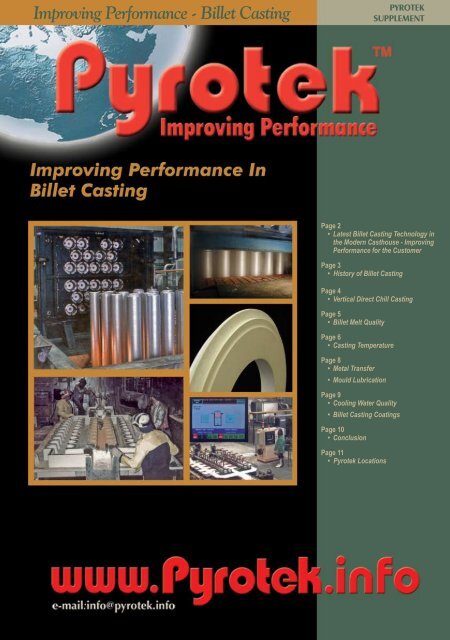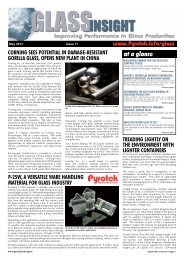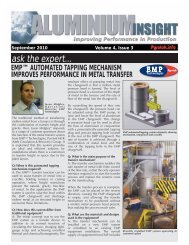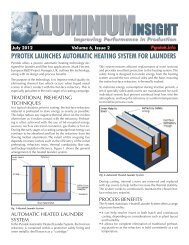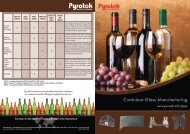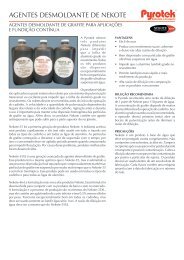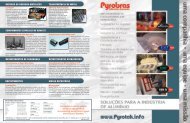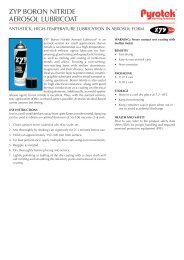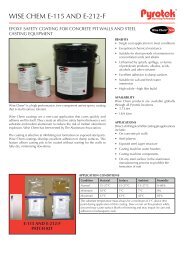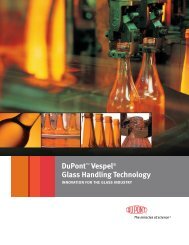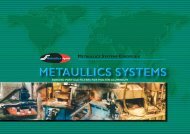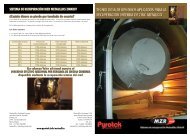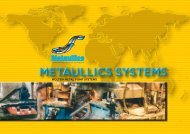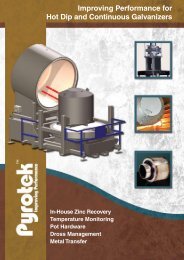Improving Performance - Billet Casting Improving ... - Pyrotek
Improving Performance - Billet Casting Improving ... - Pyrotek
Improving Performance - Billet Casting Improving ... - Pyrotek
Create successful ePaper yourself
Turn your PDF publications into a flip-book with our unique Google optimized e-Paper software.
<strong>Improving</strong> <strong>Performance</strong> - <strong>Billet</strong> <strong>Casting</strong><br />
<strong>Improving</strong> <strong>Performance</strong> - <strong>Billet</strong> <strong>Casting</strong><br />
pyrotek<br />
supplement<br />
pyrotek<br />
supplement<br />
Page 2<br />
• Latest <strong>Billet</strong> <strong>Casting</strong> Technology in<br />
the Modern Casthouse - <strong>Improving</strong><br />
<strong>Performance</strong> for the Customer<br />
Page 3<br />
• History of <strong>Billet</strong> <strong>Casting</strong><br />
Page 4<br />
• Vertical Direct Chill <strong>Casting</strong><br />
Page 5<br />
• <strong>Billet</strong> Melt Quality<br />
Page 6<br />
• <strong>Casting</strong> Temperature<br />
Page 8<br />
• Metal Transfer<br />
• Mould Lubrication<br />
Page 9<br />
• Cooling Water Quality<br />
• <strong>Billet</strong> <strong>Casting</strong> Coatings<br />
Page 10<br />
• Conclusion<br />
Page 11<br />
• <strong>Pyrotek</strong> Locations
<strong>Improving</strong> <strong>Performance</strong> - <strong>Billet</strong> <strong>Casting</strong><br />
Jonathan Prebble,<br />
Manager of<br />
Aluminium Process<br />
Technology<br />
<strong>Pyrotek</strong> has<br />
the expertise,<br />
technology,<br />
experience<br />
and the<br />
global<br />
resources to<br />
maximize the<br />
performance<br />
of your<br />
billet casting<br />
systems.<br />
Page 2<br />
LATEST BiLLET CASTing<br />
TECHnOLOgY in THE MODERn<br />
CASTHOUSE<br />
improving <strong>Performance</strong> For The<br />
Customer<br />
This year, Aluminium international<br />
Today (AiT) published a series of <strong>Pyrotek</strong><br />
articles on the processes, techniques and<br />
equipment used in Furnace Building and<br />
Repair, Furnace Melt Treatment, Degassing,<br />
Filtration, Slab and Continuous Sheet<br />
<strong>Casting</strong>.<br />
We have detailed the metal process path from<br />
the furnace to the casting process in order to<br />
demonstrate clearly why each of the various<br />
stages is necessary to achieve a final, desired<br />
metal quality designed to meet or exceed<br />
the end-customer’s expectations. This article<br />
is the last one in the series, addressing the<br />
casting of <strong>Billet</strong> in a Vertical Direct Chill<br />
(VDC) Pit.<br />
The in-line processing work which has<br />
been already undertaken (please refer to the<br />
previous articles in this AIT series) upstream<br />
of the casting pit has been required to<br />
provide the billet with the correct levels of<br />
metal cleanliness, chemistry and hydrogen<br />
content. <strong>Billet</strong> casting covers a range of<br />
alloys in many diameters for extrusion or<br />
forging applications. 1xxx, 3xxx, 6xxx, and<br />
7xxx alloys are all cast into billet form for<br />
applications that require them to be either<br />
extruded to shape or cut to blanks and<br />
forged. It is worth remembering at this point<br />
that the 6xxx series alloys are capable of<br />
being solution heat-treated as well as being<br />
quenched and aged to different tempers after<br />
extrusion. This necessitates homogenising<br />
furnaces in the casthouse area and aging<br />
ovens in the extrusion plant. Furthermore,<br />
ultrasonic non-destructive testing is usually<br />
carried out on all cast billet to ensure<br />
that there are no internal cracks or major<br />
defects present. <strong>Billet</strong> casting needs to be<br />
done correctly, requiring high investment<br />
in equipment and skill, in order to earn the<br />
premium it commands in the market.<br />
pyrotek<br />
supplement<br />
iMPROVing PERFORMAnCE in THE BiLLET<br />
CASTing PROCESS<br />
In general, most aluminium casthouses<br />
would deal with casting 6xxx series.The other<br />
alloy series are used for more specialised or<br />
exotic products for aerospace, automotive,<br />
transportation, etc. However, all billet<br />
casting requires the same basic approach<br />
to metal distribution and solidification,<br />
best performed in a VDC Pit. These pits are<br />
becoming larger and deeper to allow for<br />
more, longer cast billets because this reduces<br />
process scrap and production downtime<br />
between casts. The new casting challenges<br />
are due to operating VDC billet tables on a<br />
vast scale: more than 100 strands of billet per<br />
cast is increasingly commonplace!<br />
The upstream metal treatment, which we have<br />
focused on previously, has been designed to<br />
reduce inclusions, alkali metals and hydrogen<br />
– all or some of which can cause problems<br />
during the subsequent extrusion or forging<br />
processes. The conditions in the actual<br />
billet casting mould, however, can prove to<br />
be just as troublesome during downstream<br />
processing if the casting parameters are<br />
not well inside the “envelope”, which will<br />
produce acceptable finished quality. Here<br />
we are talking about effects such as grain-size,<br />
segregation, shell zone, cracking, surface<br />
defects including drag marks, tears, bleeds,<br />
etc., and diameter tolerances. These factors<br />
generally result from the conditions inside<br />
the actual billet casting mould - where no<br />
amount of upstream processing can assist.<br />
A good understanding of the billet casting<br />
technology being used is vitally important<br />
as this permits the right methods to be<br />
selected for the best possible productivity<br />
and performance. Most casting recipes<br />
are a compromise: a balance between the<br />
best repeatable quality achievable for a<br />
particular casting technology and practical,<br />
safe, dependable casting which can be relied<br />
upon to produce good product consistently.<br />
In this article, we will first review the<br />
various types of billet casting technology in<br />
general use today. We will also mention the<br />
importance of casting lubricant selection<br />
and how this can both improve cast surface
<strong>Improving</strong> <strong>Performance</strong> - <strong>Billet</strong> <strong>Casting</strong><br />
Figure 1a - Horizontal Direct Chill <strong>Casting</strong><br />
Figure 1b - Verticle Direct Chill <strong>Casting</strong> (picture courtesy of Wagstaff)<br />
overall consumption and greatly reduce the<br />
need for expensive chemical treatment of<br />
closed cooling water systems for the casting<br />
pits.<br />
Several aluminium casthouses, for a variety<br />
of reasons, are still confidently casting billet<br />
using the traditional conventional mould<br />
set-up, requiring a distributor basin, spouts,<br />
floats and pins. As I have mentioned before,<br />
billet casting needs to produce a product that<br />
meets or exceeds the customer’s expectations.<br />
This does not mean that the latest casting<br />
technology is either essential or even<br />
applicable to all billet casting operations. For<br />
these customers, <strong>Pyrotek</strong> supplies a variety<br />
of machined parts for spouts, pins and floats.<br />
Usually each of these is designed to fit the<br />
customer’s particular billet diameters and<br />
metal pouring conditions.<br />
Please refer to <strong>Pyrotek</strong>’s web-site for further<br />
details of our entire range of billet casting<br />
products and technical support staff who are<br />
available to assist – www.pyrotek.info.<br />
HiSTORY OF BiLLET CASTing<br />
Aluminium VDC billet casting is the process<br />
whereby molten aluminium is<br />
converted into a round ingot<br />
or billet. Although the process<br />
itself is rather straightforward,<br />
there are many variables during<br />
casting affecting the quality of<br />
the billet. Today there are two<br />
basic processes for converting<br />
molten aluminium into billet:<br />
Horizontal Direct Chill (HDC)<br />
and Vertical Direct Chill (VDC)<br />
(see Figures 1a, 1b). Each of<br />
these processes has it’s own<br />
distinct advantages. Since the<br />
output of the VDC process is<br />
by far the most widely utilised,<br />
it is therefore the focus of this<br />
article.<br />
Before the VDC process was<br />
developed, aluminium wrought<br />
billets were cast using the<br />
tilt mould ingot process. The<br />
molten aluminium was poured<br />
from a crucible into a watercooled<br />
book-mould tilted at an<br />
anglefromthehorizontal.When<br />
the aluminium in the mould<br />
reached the<br />
upper lip, it was tilted at<br />
a controlled rate until it<br />
was vertical. The tilt mould<br />
ingot was not suitable,<br />
however, for large diameter<br />
production and was limited<br />
to non heat-treatable alloys<br />
such as 1100 and 3003<br />
pyrotek<br />
supplement<br />
Alan Sale<br />
global <strong>Billet</strong> <strong>Casting</strong><br />
Specialist<br />
<strong>Billet</strong> casting<br />
needs to<br />
produce a<br />
product that<br />
meets or<br />
exceeds the<br />
customer’s<br />
expectations.<br />
For these<br />
customers,<br />
<strong>Pyrotek</strong> supplies<br />
a variety of<br />
machined parts<br />
for spouts, pins<br />
and floats.<br />
(see Figure 2). As demand Figure 2 - <strong>Casting</strong> Aluminium in a Tilt Mould<br />
for higher productivity<br />
coupled with the need for larger billets and<br />
high strength alloys increased, the VDC<br />
casting process replaced tilt mould casting in<br />
the 1930’s.<br />
Page 3
<strong>Improving</strong> <strong>Performance</strong> - <strong>Billet</strong> <strong>Casting</strong><br />
Figure 3 - Multiple<br />
VDC <strong>Billet</strong>s<br />
Page 4<br />
VERTiCAL DiRECT CHiLL<br />
CASTing<br />
The VDC casting process is the method<br />
most used today for production of<br />
commercial aluminium billets for further<br />
fabrication by either extrusion or forging.<br />
This process produces fine-grained<br />
billets with a minimum amount of<br />
segregation and at high production rates<br />
(see Figure 3). In DC billet casting, the<br />
aluminium is fed into a shallow mould,<br />
which is the same diameter as that of the<br />
planned finished billet. When the metal<br />
begins to freeze in the mould, the platen<br />
assembly is lowered at a controlled rate<br />
and cooling water is sprayed onto the<br />
surface of the solidified metal as it exits<br />
Figure 4 - Conventional Pour vs. Hot Top Mould<br />
Figure 5 - Direct Chill <strong>Casting</strong> Unit (Side View)<br />
pyrotek<br />
supplement<br />
the bottom of the mould. There are two<br />
basic designs of the VDC billet casting<br />
process today: Conventional (spout,<br />
float and control pin) and Hot Top<br />
(see Figure 4).<br />
The early conventional designs featured<br />
a ceramic downspout to allow the<br />
metal to flow under gravity from the<br />
pan or distributor into the mould. In the<br />
early days, a Marinite (Trademark of<br />
Manville Corp.) float (later replaced by<br />
modern-day calcium silicate) controlled<br />
the flow of aluminium into each mould.<br />
These systems typically suffered from<br />
oxide inclusions in the billet, slow<br />
casting speeds, lubrication problems<br />
and temperature losses (see Figure 5).<br />
The hot top system features a<br />
distribution pan that does not require<br />
floats and downspouts to deliver the<br />
molten metal to the mould. It is a true<br />
underpour system from furnace tap hole<br />
to billet solidification inside the mould.<br />
This “underpour” (molten metal below<br />
the surface skin on top of the molten<br />
metal) eliminates the oxides formed by<br />
cascading metal between the downspout<br />
and the float, as well as reducing heat<br />
loss. The early hot top systems featured<br />
either a monolithic refractory-lined<br />
distribution pan, usually formed of<br />
ceramic mouldable, or segmented<br />
water-cooled fused silica pans. As the<br />
mouldable or mastic holding the parts<br />
together in the pan cracked, spalled<br />
and degraded, ceramic inclusions in the<br />
billet increased (see Figure 6).<br />
Figure 6 - Degraded Distribution Pan
<strong>Improving</strong> <strong>Performance</strong> - <strong>Billet</strong> <strong>Casting</strong><br />
Wagstaff, Inc. further improved the hot top<br />
process in the 1970’s when they introduced<br />
their Maxicast Hot Top <strong>Billet</strong> <strong>Casting</strong><br />
system (see Figure 7). This system featured a<br />
Figure 7 - Maxicast System<br />
relatively short mould bore which allowed<br />
improved casting speeds, a porous graphite<br />
casting surface providing continuous<br />
lubrication through the graphite, a modular<br />
refractory mold table for molten metal<br />
distribution, and a self-aligning stool cap or<br />
bottom block. Furthermore, the Maxicast<br />
system was designed to “maximize” the<br />
number of billets in the casting pit so as to<br />
better utilize the full furnace and DC pit<br />
cross-sectional area capacity. Later,Wagstaff<br />
introduced the Airslip Air <strong>Casting</strong> Process<br />
mould which featured an even shorter<br />
mold bore for even faster casting speeds<br />
(see Figure 8). This technology features a<br />
Figure 8 - Airslip T-Plate<br />
porous graphite ring through which both<br />
casting gas and lubrication are introduced<br />
simultaneously, thereby producing a very<br />
smooth billet surface featuring a very thin<br />
liquation zone (see Figure 9). Today there<br />
are several variations of this technology<br />
produced by Showa, Hydro, Almex, and<br />
others, but the Wagstaff Maxicast system<br />
equipped with Airslip moulds continues<br />
to set the standard in VDC billet casting.<br />
Figure 9 - Smooth Surface with Thin Liquation Zone<br />
In general, VDC casting allows a wide<br />
spectrum of alloys to be cast with a minimum<br />
of ingot segregation because the liquid<br />
metal freezing front is almost horizontal<br />
and the metal freezes from the bottom to<br />
the top of a billet. However, regardless of<br />
the type of casting equipment in use, the<br />
actual quality of the cast billet is dependant<br />
upon many variables. Repeatable success<br />
in casting good billet quality requires<br />
constant monitoring of the actual casting<br />
parameters, such as mould fill and hold<br />
times, metal temperature, metal head<br />
height, start and run casting speeds, and<br />
cooling water consumption and quality.<br />
In addition there are many factors that can<br />
adversely affect the operating parameters,<br />
which, in turn, determine the finished cast<br />
billet quality.<br />
BiLLET MELT QUALiTY<br />
Melt quality is by far the most important factor<br />
in making a good quality billet. Even the best<br />
casting equipment, with all the operating<br />
parameters maximized, can only produce the<br />
quality of what is put into it. Previous articles<br />
in this AIT series have included technical<br />
discussions on furnace melt treatment,<br />
filtration, and in-line degassing. These will<br />
not be discussed further here; however, a few<br />
highlights are worthwhile mentioning.<br />
Alkali metals such as sodium, calcium,<br />
and lithium, are often overlooked in the<br />
process. These can be found in both primary<br />
and secondary casthouses. These elements<br />
often affect the quality of the extrusion and<br />
extrusion die life. Refining agents such as<br />
<strong>Pyrotek</strong>’s Promag, when used in conjunction<br />
with good furnace treatment principals, can<br />
keep these elements to a minimum (see Figure<br />
pyrotek<br />
supplement<br />
Robert Bridi, global<br />
Product Manager,<br />
Fluxes, Refining<br />
Agents & Lubricants<br />
The quality of<br />
the cast billet<br />
is dependant<br />
upon many<br />
variables.<br />
Repeatable<br />
success in<br />
casting good<br />
billet quality<br />
requires<br />
constant<br />
monitoring<br />
of the casting<br />
parameters.<br />
Page 5
Page 6<br />
<strong>Improving</strong> <strong>Performance</strong> - <strong>Billet</strong> <strong>Casting</strong><br />
10). Another common source of calcium is<br />
introduced through the use of bone ash.<br />
In addition, it is a major contaminator of<br />
cooling water. <strong>Pyrotek</strong> offers a complete line<br />
of effective boron nitride coatings to help<br />
facilitate scull removal and<br />
eliminate bone ash (see Figure<br />
11). In addition, an effective<br />
degassing system with a heated<br />
tub will deliver the first shot of<br />
metal at the desired casting<br />
temperature while removing<br />
hydrogen along with some<br />
of these alkali metals. SNIF ®<br />
Figure 10 - Promag Refining Agents systems are ideal in allowing<br />
clean initial metal at the right<br />
temperature for successful cast<br />
starts and with minimum scrap<br />
generation due to butt crop.<br />
This degassing system also<br />
eliminates the need to dump<br />
the first 1-1.5 tons into a drain<br />
sow mould, as is the practice<br />
Figure 11 - ZYP Bn Coatings with some in-line trough<br />
degassing systems, in order to<br />
ensure that the metal is at the<br />
right casting temperature (see<br />
Figure 12).<br />
CASTing<br />
TEMPERATURE<br />
<strong>Casting</strong> temperature is<br />
critical in order to achieve<br />
good segregation and grain<br />
distribution inside the<br />
finished billet. Not only must<br />
the molten metal be delivered<br />
to the mould at the correct<br />
Figure 12 - SniF P180UHB temperature, but the molten<br />
metal inside the mould must<br />
also be within designed parameters in<br />
order to produce good quality billet. There<br />
are usually three zones where temperature<br />
is lost. The first is between the tap-hole<br />
in the furnace and the in-line degassing<br />
process. Many casthouses are forced to<br />
compromise by using long launder runs<br />
so as to best accommodate their melting<br />
and holding furnace layout. Raising the<br />
metal temperature in the furnace is risky<br />
because the higher the temperature is, the<br />
higher the hydrogen and oxide generation<br />
tends to be. Temperature loss can be<br />
significantly reduced by an effective<br />
combination of refractory, insulation and<br />
launder covers (see Figure 13). <strong>Pyrotek</strong><br />
supplies a wide range<br />
of refractories ranging<br />
from Insural 140 up<br />
to Pyrocast AR Plus.<br />
When combined<br />
with <strong>Pyrotek</strong>’s<br />
Wollite as the backup<br />
insulation, the<br />
launder systems offer<br />
a long service life<br />
as well as reduced<br />
temperature loss (see<br />
Figure 14).<br />
Figure 14 - <strong>Pyrotek</strong> Heated Trough System<br />
pyrotek<br />
supplement<br />
Figure 13 - Launder<br />
Cover<br />
The next zone where temperature is lost<br />
is between the in-line degassing box and<br />
Ceramic Foam Filter (CFF) box, and the entry<br />
to the casting tabletop. As stated previously,<br />
a heated degassing box, such as a SNIF ®<br />
system, ensures temperatures stay within<br />
a specified range. Correct heating of the<br />
CFF before the furnace is tapped will also<br />
help to eliminate temperature loss as well<br />
as ensuring that the CFF functions properly,<br />
(see Figure 15).<br />
Figure 15 - Sivex ® Ceramic Foam Filter Box
<strong>Improving</strong> <strong>Performance</strong> - <strong>Billet</strong> <strong>Casting</strong><br />
The third zone of<br />
temperature loss occurs<br />
across the casting table<br />
itself - from the metal<br />
entry point to the furthest<br />
end of the table. On<br />
larger tables, or even on<br />
tables with a very long<br />
metal flow distance, this<br />
can be critical because<br />
the first mould positions<br />
start to solidify or freeze<br />
even though the last<br />
positions are still filling.<br />
This can result in either<br />
hot butt separation or<br />
cold butt separation (or<br />
sometimes both). It is<br />
essential that the selected<br />
tabletop refractory<br />
allow the molten metal<br />
to stay at the correct<br />
casting temperature (insulates) as well as<br />
protecting the steelwork in the tabletop<br />
structure from warping due to heat. A good<br />
refractory should not lose its retained heat<br />
too rapidly between casts, nor continue to<br />
store heat after the cast. Over the past few<br />
years, <strong>Pyrotek</strong> has developed a refractory<br />
system that addresses both of these<br />
issues. The attached graph (see Figure 16)<br />
displays actual temperature measured<br />
with thermocouples. Insural 140, when<br />
used with Wollite as a back-up insulation,<br />
provides a longer life refractory with good<br />
insulation (see Figure 17).<br />
Personal safety and health of casthouse<br />
personel, and the sensitivity to our<br />
environment continue to be major<br />
concerns. The industry continually<br />
searches for ways to reduce emissions,<br />
environmental waste, and harmful<br />
substances. <strong>Pyrotek</strong>’s refractory materials<br />
Figure 17 - Filling a Wagstaff table with Wollite 30ST<br />
Figure 16 - insural 140 vs. Pyrofoam PC / HP<br />
pyrotek<br />
supplement<br />
for hot top billet casting contain no<br />
ceramic fibre. This reduces any exposure<br />
of plant personnel to<br />
potentially harmful RCF<br />
(Refractory Ceramic<br />
Fibre) particles during<br />
refractory maintenance<br />
and repair activities.<br />
To complement these<br />
refractories, <strong>Pyrotek</strong> has<br />
now introduced a nonrespirable<br />
RCF moldable/<br />
mastic which is both easy<br />
to use and very effective.<br />
Figure 18 - Wagstaff Mould with n-17<br />
With hot top systems, it<br />
is important to regulate<br />
metal temperature inside<br />
the mould. A header<br />
plate, or transition<br />
plate, helps to insulate<br />
the molten metal so as<br />
to maintain a uniform<br />
temperature throughout<br />
the cast (up to 7.5 metres<br />
in length). Dense silica Figure 19 - Wagstaff Mould<br />
cast plates can be used (courtesy of Wagstaff)<br />
in some systems, but<br />
usually at the sacrifice of start defects and<br />
temperature build-up in the mould during<br />
the length of the cast. <strong>Pyrotek</strong>’s N-17, a<br />
premium calcium silicate, is the standard<br />
in the industry for transition and header<br />
plate application (see Figure 18 and 19).<br />
Page 7
Page 8<br />
<strong>Improving</strong> <strong>Performance</strong> - <strong>Billet</strong> <strong>Casting</strong><br />
<strong>Pyrotek</strong>’s<br />
range of<br />
Perlube<br />
lubricants<br />
offer superior<br />
lubrication<br />
matched to<br />
each specific<br />
process.<br />
Most billet<br />
casters will<br />
consume up<br />
to ten times<br />
less Perlube<br />
than other<br />
vegetable<br />
or synthetic<br />
lubricants<br />
while not<br />
contaminating<br />
the cooling<br />
water system<br />
as much.<br />
METAL TRAnSFER<br />
Getting metal from the metal distributor<br />
into the mould usually happens in three<br />
ways. Certain hot top technologies<br />
simply flood an orifice through a narrow<br />
channel between the metal distributor<br />
and the mould. Hydro and Showa are<br />
examples of this type of system. In<br />
conventional tables, a downspout, or dip<br />
tube, is commonly used in conjunction<br />
with a float to control the metal flow<br />
into the mould. As stated earlier, these<br />
systems usually generate more oxides.<br />
Controlling the metal temperature<br />
is critical to prevent the spouts from<br />
freezing. <strong>Pyrotek</strong> continues to offer a<br />
wide range of float and spout designs<br />
manufactured from calcium silicate<br />
to accommodate this process. These<br />
materials insulate and offer long service<br />
life for maximum operating economy<br />
(see Figure 20).<br />
Figure 20 - <strong>Pyrotek</strong> Floats and Pins<br />
Wagstaff hot top systems (see Figure<br />
21), however, utilize a thimble, located<br />
between the metal distribution refractory<br />
and the mould. The thimble directs the<br />
molten metal into the mould so it must<br />
have a very smooth internal diameter, as<br />
well as being capable of withstanding<br />
metal erosion, thermal shock, and any<br />
damage associated with maintenance<br />
and cleaning between casts. Since the<br />
outer diameter of the thimble mates with<br />
the internal diameter of the T-plate with<br />
a soft seal gasket made from ceramic<br />
paper between them, the machined<br />
tolerances of both parts are critical.<br />
<strong>Pyrotek</strong>’s unique mould process during<br />
thimble manufacture allows the bottom<br />
outer diameter of the thimble to have<br />
very tightly controlled concentricity,<br />
thereby ensuring a perfect fit between<br />
the thimble and the T-plate. In addition,<br />
pyrotek<br />
supplement<br />
each production batch of thimbles is<br />
produced to a very strict manufacturing<br />
standard utilising electronic and<br />
physical inspection techniques. The<br />
techniques identify basic porosity and<br />
dimentional tolerances, which are<br />
directly related to the strength and life<br />
of the thimble.<br />
Figure 21 - <strong>Pyrotek</strong> Hot Top Systems for Wagstaff<br />
MOULD LUBRiCATiOn<br />
Lubrication inside the mould plays a<br />
very important part in casting product with<br />
good surface quality. Most conventional<br />
systems utilise a mould bore grease or brushon<br />
lubricant. During the length of the cast,<br />
however, this lubricant is dissipated which<br />
results in billet surface defects. Most hot top<br />
systems employ some type of continuous<br />
lubrication system. These systems can<br />
range from a simple serrated copper plate<br />
between the mould bore and header plate,<br />
where lubricant oozes down the mold<br />
bore, to a sophisticated pressurized, timed<br />
injection system. There is a tendency to use<br />
too much oil when trying to correct surface<br />
defects usually caused by other variables.<br />
This in turn contaminates casting machines<br />
and cooling water, causing more chemicals<br />
to have to be added to the cooling water<br />
to maintain its quality, which often affects<br />
the water’s ability to adequately quench the<br />
metal in the mould. In many casthouses,<br />
the billet cooling water system is a common<br />
one shared with other pits where sheet ingot<br />
is cast, which is a very big oil contaminator<br />
of the water. <strong>Pyrotek</strong>’s range of Perlube<br />
lubricants offer every type of billet caster a<br />
superior lubricant matched to his specific<br />
process. The advantage is that most billet<br />
casters will consume up to ten times less<br />
Perlube than other vegetable or synthetic<br />
lubricants whilst the Perlube oils do not<br />
contaminate the cooling water system<br />
anywhere near as much because they
<strong>Improving</strong> <strong>Performance</strong> - <strong>Billet</strong> <strong>Casting</strong><br />
Figure 22 - Cooling Water<br />
Figure 23 - Mould and Hoses<br />
are >95% biodegradable (Figure 22). This<br />
solution can also save considerable chemical<br />
treatment costs.<br />
COOLing WATER QUALiTY<br />
Cooling water quality plays a critical role<br />
in good billet casting. Some conventional<br />
systems today still use a mould table, which<br />
has external cooling hoses to each of the<br />
moulds (see Figure 23). Most hot top systems<br />
use a Wagstaff-type mould table with integral<br />
water headers that feed cooling water directly<br />
from inside the tabletop to the moulds. A baffle<br />
system, with water screens, is usually used to<br />
prevent large pieces of debris from plugging<br />
the water slots or holes in the mould bore. This<br />
again becomes critical because, if the cooling<br />
water system becomes oil contaminated, then<br />
the water screens quickly become clogged,<br />
with debris from algae and bacteria, thereby<br />
causing hot tears and bleed-outs during the<br />
cast. Many cooling systems are at or near<br />
maximum capacity during casting, and when<br />
more chemicals are added to the cooling water,<br />
the effect of cooling is diminished. As discussed<br />
above, the biodegradable and economical<br />
<strong>Pyrotek</strong> Perlube product range can greatly<br />
reduce oil contamination in the cooling water<br />
and the consequent chemical treatment costs.<br />
BiLLET CASTing COATingS<br />
Coatings also play an important role in<br />
producing good quality billet: in particular<br />
the application of boron nitride and graphite<br />
coatings for T-plates. A good non-wetting<br />
coating will minimize oxide adhesion at cast<br />
start, allowing the billet to get into steady-state<br />
casting mode quickly. This can help to reduce<br />
bottom butt scrap. <strong>Pyrotek</strong> has developed a<br />
premium, proprietary coating for this purpose.<br />
This boron nitride based coating, applied at the<br />
<strong>Pyrotek</strong> factory, withstands 30–40 casts before<br />
recoating of the T-plate becomes necessary.<br />
It also has superior lubricity for good oxide<br />
mobility. T-Kote, an “easy-to-use” companion<br />
coating was developed to enhance protection<br />
of the T-plate. T-Kote comes premixed and<br />
has a slight tint, allowing the operator to<br />
see visually where any spots may have been<br />
missed. Combined, these two products also<br />
offer superior life to the surface of the transition<br />
plate.<br />
Graphite coating is used in<br />
some transition plate and<br />
header coating applications.<br />
It does not offer the lubricity<br />
of boron nitride, but provides<br />
more penetration of the hot<br />
face of the transition plate and<br />
resistance to some metal alloy<br />
constituents less compatible<br />
with boron nitride. <strong>Pyrotek</strong><br />
offers a Naphtha-based graphite coating<br />
called Pyroslip 325/350 (see Figure 24).<br />
Since molten aluminium is very aggressive, a<br />
release agent should be applied to protect the<br />
launder and table surfaces coming into contact<br />
with the metal. Boron nitride coatings and<br />
bone ash are utilised in such applications. In<br />
contrast the binders utilised for the BN coatings<br />
adhere strongly to the various refractory<br />
materials and assist in reducing metal erosion<br />
of the refractory shapes, reducing the damage<br />
associated with maintenance and cleaning<br />
between casts, and with the addition of a blue<br />
colorant, provides an additional assistance<br />
in helping to monitor the effectiveness of<br />
the coating practice. Traditionally, bone ash<br />
was used because of its release properties.<br />
However, due to its poor adhesion, bone<br />
ash must be repeatedly replenished and may<br />
become entrained by the flowing of molten<br />
aluminium. Customers report that in contrast<br />
to bone ash, major reductions in residues and<br />
quicker turn around of casting tables helped<br />
Figure 24 - Pyroslip Products<br />
pyrotek<br />
supplement<br />
John Blasen<br />
global Market<br />
Development Manager,<br />
ZYP - <strong>Pyrotek</strong> Coatings<br />
PYROTEK’S<br />
MiSSiOn<br />
“Providing<br />
innovative<br />
solutions<br />
to customer<br />
needs<br />
utilizing<br />
our global<br />
resources.”<br />
Page 9
Page 10<br />
<strong>Improving</strong> <strong>Performance</strong> - <strong>Billet</strong> <strong>Casting</strong><br />
improve their profitability. <strong>Pyrotek</strong> is the<br />
exclusive distributor for the world’s largest<br />
supplier of the highest quality BN coatings,<br />
ZYP ® Coatings Inc. and stand ready to assist<br />
Figure 25 - Wise Chem Safety Coating with conversion techniques<br />
and practices to maximize<br />
the performance of their<br />
release coatings.<br />
<strong>Pyrotek</strong><br />
has several<br />
integrated<br />
materials to<br />
ensure its<br />
customer’s<br />
billet casting<br />
process is<br />
optimized to<br />
its maximum<br />
potential.<br />
Joe Roberts<br />
global Market<br />
Development<br />
Manager,<br />
Safety Coatings<br />
Safety is at the forefront of<br />
practically all aluminium<br />
casthouses in the world.<br />
Whenever rust, moisture,<br />
lime (leached from concrete<br />
in the pit) and molten<br />
aluminium come into<br />
close contact, then all the<br />
hazardous conditions exist<br />
for a destructive molten<br />
metal explosion. It is<br />
imperative to monitor the<br />
steel casting equipment and<br />
casting machines for signs of<br />
rust and exposure. <strong>Casting</strong><br />
pits should be inspected periodically and<br />
recoated as needed. <strong>Pyrotek</strong> offers Wise Chem<br />
pyrotek<br />
supplement<br />
safety coatings, which have been tested and is<br />
recognised by the Aluminium Association as<br />
an effective safety coating (see Figure 25).<br />
COnCLUSiOn<br />
To summarize, in addition to maximizing<br />
casting parameters, the selection of the right<br />
system of consumables can have a major<br />
impact on a plants ability to consistently cast<br />
good quality billet. <strong>Pyrotek</strong> does not offer<br />
one single product, but has several integrated<br />
materials to ensure its customer’s billet<br />
casting process is optimized to its maximum<br />
potential. <strong>Pyrotek</strong> also provides a unique level<br />
of worldwide, in-the-plant technical support<br />
and process expertise. This combination of<br />
technical support/expertise and consistent<br />
local service enables <strong>Pyrotek</strong> customers to<br />
make the correct material selections and<br />
employ them properly, thereby deriving the<br />
best potential performances from whichever<br />
casting technology they choose to employ.<br />
For additional information on billet casting<br />
go to www.pyrotek.info/billet.
<strong>Improving</strong> <strong>Performance</strong> - <strong>Billet</strong> <strong>Casting</strong><br />
PYROTEK’S MAJOR LOCATiOnS<br />
ASiA<br />
CHINA, Shenzhen<br />
Phone: (86) 755-26632324<br />
e-mail: shenzhen@pyrotek.info<br />
INDIA, Pune<br />
Phone: (91) 21-375-6800<br />
e-mail: pune@pyrotek.info<br />
INDONESIA, Jakarta<br />
Phone: (62) 21-563-8507<br />
e-mail: jakarta@pyrotek.info<br />
JAPAN, Kobe<br />
Phone: (81) (0)78-265-5590<br />
e-mail: kobe@pyrotek.info<br />
KOREA, Daegu<br />
Phone: 82 (0)53-523-5202<br />
e-mail: korea@pyrotek.info<br />
MALAYSIA, Kuala-Lumpur<br />
Phone: (603) 5631-3096<br />
e-mail: kualalumpur@pyrotek.info<br />
TAIWAN, Kaohsiung City<br />
Phone: (886) 7-224-8222<br />
e-mail: taiwan@pyrotek.info<br />
THAILAND, Bangkok<br />
Phone: (66) (0) 2 361-4870<br />
e-mail: bangkok@pyrotek.info<br />
AUSTRALiA<br />
AUSTRALIA (ANZ HEADQUARTERS)<br />
Phone: (61) (0)2 9631-1333<br />
e-mail: sydney@pyrotek.info<br />
CAnADA<br />
QUEBEC, Drummondville<br />
Phone: (819) 477-0734<br />
e-mail: drummondville@pyrotek.info<br />
EUROPE<br />
CZECH REPUBLIC, Blansko<br />
Phone: (420) (0) 516-527-111<br />
e-mail: blansko@pyrotek.info<br />
GERMANY, Grevenbroich<br />
Phone: (49) (0)2182-8-10-20<br />
e-mail: grevenbroich@pyrotek.info<br />
SWEDEN, Ed<br />
Phone: (46) (0) 534-62000<br />
e-mail: ed@pyrotek.info<br />
SWITZERLAND, Sierre<br />
Phone: (41) (0)27-455-82-64<br />
e-mail: sierre@pyrotek.info<br />
UNITED KINGDOM, Milton<br />
Keynes<br />
Phone: (44) (0)1 908-561155<br />
e-mail: miltonkeynes@pyrotek.info<br />
MEXiCO<br />
MEXICO, Santa Catarina<br />
Phone: (52) 81-8336-9117<br />
e-mail: mexico@pyrotek.info<br />
MiDDLE EAST<br />
UNITED ARAB EMIRATES, Dubai<br />
Phone: (971) (0)4-883-77-00<br />
e-mail: dubai@pyrotek.info<br />
nEW ZEALAnD<br />
NEW ZEALAND, Auckland<br />
Phone: (64) (0)9 272-2056<br />
e-mail: auckland@pyrotek.info<br />
RUSSiA/CiS<br />
RUSSIA/CIS, Moscow<br />
Phone: (7) 095-230-71-63<br />
e-mail: moscow@pyrotek.info<br />
SOUTH AFRiCA<br />
REPUBLIC OF SOUTH AFRICA,<br />
Richards Bay<br />
Phone: (27) (0)35 7974039<br />
e-mail: richardsbay@pyrotek.info<br />
View this suppliement online at www.pyrotek.info/billet_casting<br />
Read other supplements in this series:<br />
SOUTH AMERiCA<br />
BRASIL, São Paulo<br />
Phone: (55) (0)11-4786-5233<br />
e-mail: saopaulo@pyrotek.info<br />
VENEZUELA, Puerto Ordaz<br />
Phone: (58) 286-994 1894<br />
e-mail: puertoordaz@pyrotek.info<br />
U.S.A.<br />
CALIFORNIA, Cerritos<br />
Phone: (562) 623-0085<br />
e-mail: cerritos@pyrotek.info<br />
INDIANA, Columbia City<br />
Phone: (260) 248-4141<br />
e-mail: columbiacity@pyrotek.info<br />
INDIANA, Evansville<br />
Phone: (812) 867-6343<br />
e-mail: evansville@pyrotek.info<br />
NEW YORK, Canastota<br />
Phone: (315) 697-8410<br />
e-mail: canastota@pyrotek.info<br />
NEW YORK, Elmsford<br />
Phone: (914) 345-4740<br />
e-mail: elmsford@pyrotek.info<br />
NORTH CAROLINA, Salisbury<br />
Phone: (704) 642-1993<br />
e-mail: salisbury@pyrotek.info<br />
OHIO, Solon<br />
Phone: (440) 349-8800<br />
e-mail: solon@pyrotek.info<br />
PENNSYLVANIA, Carlisle<br />
Phone: (717) 249-2075<br />
e-mail: carlisle@pyrotek.info<br />
WASHINGTON, Spokane Valley<br />
Phone: (509) 926-6211<br />
e-mail: spokane@pyrotek.info<br />
Explore the many filtration solutions to improve your melt quality at www.pyrotek.info/filtration<br />
Learn more about improving performance in your furnace operations at www.pyrotek.info/furnace_operations<br />
Improve your furnace melt treatment process with information at www.pyrotek.info/melt_treatment<br />
Find out about solutions for the degassing process at www.pyrotek.info/degassing<br />
Investigate how to improve your slab casting processes at www.pyrotek.info/slab_casting<br />
Read more about continuous casting solutions at www.pyrotek.info/continuous_casting<br />
pyrotek<br />
supplement<br />
<strong>Pyrotek</strong> is<br />
unique in<br />
its ability to<br />
provide the<br />
integration<br />
of innovative<br />
technologies,<br />
process<br />
expertise<br />
and a global<br />
perspective.<br />
CORPORATE<br />
OFFICE<br />
9503 East Montgomery Avenue<br />
Spokane Valley, WA 99206<br />
Phone: (509) 926-6212<br />
Fax: (509) 927-2408<br />
e-mail: info@pyrotek.info<br />
Visit<br />
<strong>Pyrotek</strong><br />
online<br />
at<br />
www.pyrotek.info<br />
Page 11
<strong>Improving</strong> <strong>Performance</strong> - <strong>Billet</strong> <strong>Casting</strong><br />
pyrotek<br />
supplement


